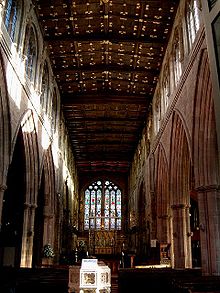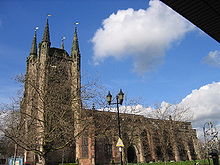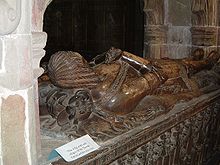- Church of St Editha, Tamworth
-
Church of St Editha 52°38′03″N 1°41′39″W / 52.6342°N 1.6943°WCoordinates: 52°38′03″N 1°41′39″W / 52.6342°N 1.6943°W Denomination Church of England Website http://www.stedithas.org.uk/welcome.html History Dedication Saint Editha Administration Diocese Diocese of Lichfield Province Canterbury The Church of St Editha is an Anglican parish church and Grade I listed building in Tamworth, Staffordshire, England.[1][2]
Contents
History
The church of St. Editha is the largest medieval parish church in Staffordshire. Most of the church is mid to late 14th century and 15th century work with some 19th century additions.
The present building stands upon the ground where successive churches have stood since the eighth century. The first church was destroyed, along with the town, by the Danes in 874 and it was not until the time of Ethelfleda that a second church arose. The Danes ruined this church in 943 and it was King Edgar who re-founded it around 963. Editha, King Edgar's aunt died in 960 and was canonized shortly after for her life of devotion and piety and was then made the Patron Saint of the now collegiate church.
In 1345 the town and church were destroyed by fire and the rebuilding of the fourth and present church was undertaken. Begun in 1350 and completed in 1369, this edifice is a monument to the man whose task it became to rebuild and enlarge the church, Dean Baldwin de Witney.
The College of Canons of St. Editha was probably a royal foundation in the 10th century, although the date of foundation is unknown. Although the right to appoint Canons was disputed, by the 12th century, all appointments were Royal. There were a Dean and six prebendaries.
The college was dissolved in 1548 under the terms of the Dissolution of Colleges Act 1547[3] and the church became the parish church for the town of Tamworth.
Samuel Parkes (c.1815-1864) was baptised here on 24 December 1815. He won the Victoria Cross in the Charge of the Light Brigade for saving the life of Trumpeter Hugh Crawford. His parents Thomas Park(e)s and Lydia Fearn are buried in the churchyard and commemorated by a tombstone.
The church was extensively restored by Benjamin Ferrey and George Gilbert Scott in the 1850s, and William Butterfield, ca. 1871. There is a unique double spiral staircase in the tower.
Stained glass
There are medieval fragments in the vestry east window. The chancel east window dates from 1870, by William Wailes.[4]
There are south clerestory windows of 1873, by Ford Madox Brown for Morris and Co
The chapel east window of 1874 is by Edward Burne-Jones for Morris and Co.
Organ
The church has an historic pipe organ dating from 1766. The first instrument was installed by Nathaniel Dudley. Samuel Green built a new organ in 1792, taking the Dudley organ to Isleworth in South West London. Alexander Buckingham added a chair/choir division in 1809 and a pedal division was added by William Hill in 1841. Further work was carried out by George Holdich, Brycesons Bros and finally Nicholsons of Worcester. A new organ was built in 1927 by Harrison and Harrison incorporating much of the old pipework and is expected to be restored in 2009/2010[5]. A specification of the organ from 1929 can be found on the National Pipe Organ Register
Organists
- John Alcock 1766 - 1790
- William Birch 1790 - 1815
- John Valentine 1815 - 1816
- Thomas Valentine 1816 - 1818
- John T. Greaves 1818 - 1828
- John Hewitt 1828 - 1829
- James J. Greaves 1829 - 1832
- John T. Greaves 1832 - 1867
- T. H. Reade 1867 - 1868
- J. Smith Creswell 1868 - 1874
- George Herbert Gregory 1874 - 1876[6] (afterwards organist of St Botolph's Church, Boston
- W. E. Wadley 1876 - 1877
- R. Matthews 1877 - 1886
- Henry Rose 1886 - 1950
- W. Darling 1950 - 1965
- W. H. Hughes 1965 - 1972
- Kenneth Edwards 1973 -
In 1929, Henry Rose appointed the then 13 year old Sir Ernest Titterton as assistant organist. Sir Ernest later went on to help develop the Atomic Bomb.[7]
-
This list is incomplete; you can help by expanding it.
See also
- Saint Editha
- Dissolution of the Monasteries
- Grade I listed buildings in Staffordshire
References
- ^ Details from listed building database (386462) - Grade I. Images of England. English Heritage.
- ^ Listed Buildings Online -Church Of St Editha
- ^ 'Colleges: Tamworth, St Edith', A History of the County of Stafford: Volume 3 (1970), pp. 309-315.
- ^ Lives of the Queens of England
- ^ http://www.harrison-organs.co.uk/plans.html
- ^ Love, James Scottish Church Music; p. 147
- ^ http://www.asap.unimelb.edu.au/bsparcs/aasmemoirs/titterto.htm
External links
Categories:- Grade I listed buildings in Staffordshire
- Church of England churches in Staffordshire
Wikimedia Foundation. 2010.



